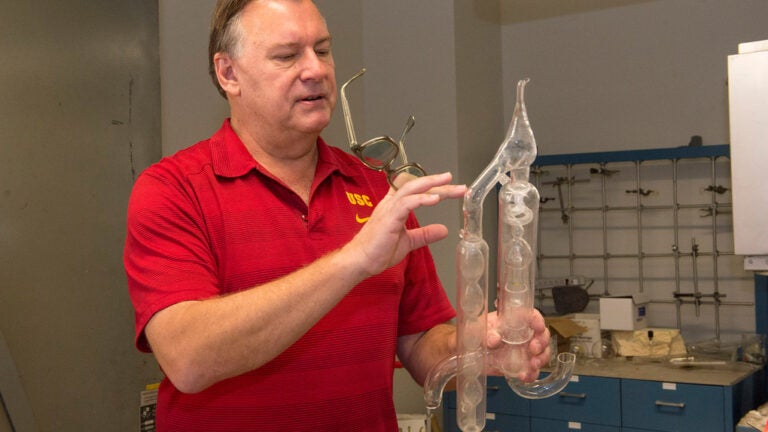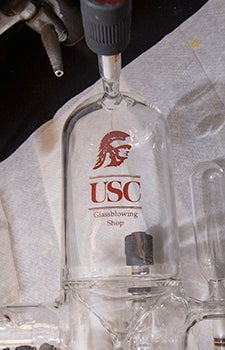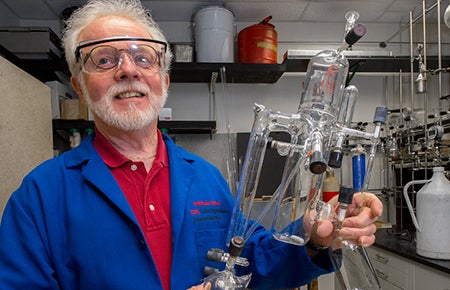
USC’s scientific glassblower plays a crucial role in turning chemists’ dreams into reality
Phillip Sliwoski is surrounded by glass — on his desk, in cabinets, in big bins at his feet.
He’s a scientific glassblower, which means he designs the glass instruments that chemistry professors and students need for experiments. He’s been at USC Dornsife’s Department of Chemistry for nearly 10 years and is a symbol of a fading art form.
Scientific glassblowers used to populate research universities and corporate labs across the U.S., but due to everything from budget cuts to automation, they’re increasingly scarce. The American Scientific Glassblowers Society has seen its membership drop by 50 percent since the 1970s.
But scientific glassblowers are imperative for chemists who design glassware for their unique chemical reactions. This isn’t stuff you can order in a catalog.

A signature piece from USC’s glassblowing shop.
“I make one-of-a-kind items here,” Sliwoski said.
Sliwoski is one of only a few glassblowers left in Los Angeles — Caltech is getting a new one and California State University, Los Angeles has one part-time.
“It’s an art that’s been around for 1,000 years,” Sliwoski said. “You don’t want it to disappear. … No matter what, with automation and everything, there’s stuff we still need that is made out of glass.”
G. K. Surya Prakash, George A. and Judith A. Olah Nobel Laureate Chair in Hydrocarbon Chemistry and professor of chemistry, said his work would literally grind to a halt if it weren’t for Sliwoski.
“All special experiments would stop if we don’t have a guy like Phil in-house,” he said. “Phil is indispensable.”
Outsourcing would likely cost more, take longer and leave the department without someone who can make sure an object works — and repair it if needed, faculty said.
Prakash pointed out that glassblowing has always been integral to science. It used to be the norm to take graduate school courses in it. He learned his trade while attending graduate school in both India and Ohio.
“Glassblowing is an art. It takes years and years to become proficient at it,” Prakash said.

Chemistry Professor William Wilson’s team researches rocket propellants, relying on scientific glassblower Phillip Sliwoski’s skills when designing experiments.
Sitting at his bench burner — a flame of 1,500 degrees Fahrenheit burning in front of him — Sliwoski informs you he’s not an artist “like what you see in Venice.”
Scientific glassblowing is more exact, he said, because he’s taking parts and melting them together. But he’s also creating things never made before.
“In some ways, he’s an artist and in some ways, he’s a very sophisticated engineer,” said Professor Mark Thompson, who holds the Ray. R. Irani Chairman of Occidental Petroleum Corporation Chair in Chemistry.
Students will walk in with a complex plan or design and walk out with something much simpler, thanks to Sliwoski, he said.
“My colleagues at other schools don’t have this ability. It enables us to do things that other people just can’t do,” Thompson said. “With Phil, the sky is the limit.”